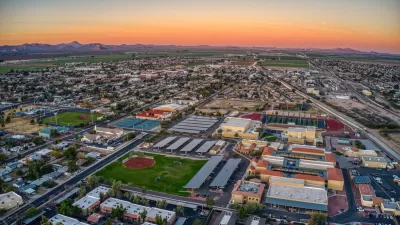The Colorado River is struggling to provide enough water for 25 million people, which could lead to water shortages and water wars in the areas that rely on its bounty. Officials are looking to find a long-term solution, reports Felicity Barringer.
"As far as future water supplies go, the outlook is not good," says Barringer. "Most Colorado River water is currently used for agriculture, but that is beginning to shift as the cities of the Southwest continue to grow." The basin is next to fall victim to America's water crisis as the demand for water exceeds supply, and the effects of climate change could bring less rain to the region. The Bureau of Reclamation has been considering traditional solutions to the water shortage including "decreasing demand through conservation and increasing supply through reuse or desalination projects," but "a more extreme and contentious approach" is the building of a 600-mile pipeline from the Missouri River to Denver that would provide water as needed and store the remaining in reservoirs. Experts say "the plan is reminiscent of those proposed in the middle of the last century, when grand and exorbitant federal water projects were common place — and not, with the benefit of hindsight, always advisable," which shows just how serious the problem has become for the Colorado River.
The pipeline would provide the Colorado River with 600,000 acre-feet of water annually from the Missouri and Missippi River systems, enough to serve roughly a million single-family homes, but the loss of water from those rivers would likely face strong opposition from the affected states. The project would also require local taxpayers and utility customers to shoulder the costs of the project, which could cost billions of dollars. The proposal "shows you the degree to which water-short entities in the Colorado River basin are willing to go to get water" from somewhere elsewhere, said Burke W. Griggs, the counsel for the Kansas Agriculture Department's division of water resources. If the Colorado River cannot supply enough water, the fear is that water wars could restart as states fight over dwindling water sources. Jason Bane of Western Resource Advocates described the pipeline idea as "fundamentally 20th-century water-policy thinking that doesn't work in the 21st century" and said, "We clearly need to conserve and be more efficient with the water we have."
FULL STORY: Water Piped to Denver Could Ease Stress on River

Pennsylvania Mall Conversion Bill Passes House
If passed, the bill would promote the adaptive reuse of defunct commercial buildings.

Coming Soon to Ohio: The Largest Agrivoltaic Farm in the US
The ambitious 6,000-acre project will combine an 800-watt solar farm with crop and livestock production.

World's Largest Wildlife Overpass In the Works in Los Angeles County
Caltrans will soon close half of the 101 Freeway in order to continue construction of the Wallis Annenberg Wildlife Crossing near Agoura Hills in Los Angeles County.

California Grid Runs on 100% Renewable Energy for Over 9 Hours
The state’s energy grid was entirely powered by clean energy for some portion of the day on 37 out of the last 45 days.

New Forecasting Tool Aims to Reduce Heat-Related Deaths
Two federal agencies launched a new, easy-to-use, color-coded heat warning system that combines meteorological and medical risk factors.

AI Traffic Management Comes to Dallas-Fort Worth
Several Texas cities are using an AI-powered platform called NoTraffic to help manage traffic signals to increase safety and improve traffic flow.
City of Costa Mesa
Licking County
Barrett Planning Group LLC
HUD's Office of Policy Development and Research
Mpact Transit + Community
HUD's Office of Policy Development and Research
Tufts University, Department of Urban and Environmental Policy & Planning
City of Universal City TX
ULI Northwest Arkansas
Urban Design for Planners 1: Software Tools
This six-course series explores essential urban design concepts using open source software and equips planners with the tools they need to participate fully in the urban design process.
Planning for Universal Design
Learn the tools for implementing Universal Design in planning regulations.


























